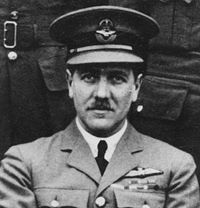Jack Baldwin (RAF officer): Difference between revisions
m Bot: Migrating 1 interwiki links, now provided by Wikidata on d:q6111127 |
m Robot - Moving category Royal Air Force World War II air marshals to Category:Royal Air Force air marshals of World War II per CFD at Wikipedia:Categories for discussion/Log/2014 January 8. |
||
| Line 95: | Line 95: | ||
[[Category:1975 deaths]] |
[[Category:1975 deaths]] |
||
[[Category:Aviation pioneers]] |
[[Category:Aviation pioneers]] |
||
[[Category:Royal Air Force World War II |
[[Category:Royal Air Force air marshals of World War II]] |
||
[[Category:Knights Commander of the Order of the British Empire]] |
[[Category:Knights Commander of the Order of the British Empire]] |
||
[[Category:Companions of the Order of the Bath]] |
[[Category:Companions of the Order of the Bath]] |
||
Revision as of 17:20, 16 January 2014
Sir John Eustice Arthur Baldwin | |
|---|---|
 Wg Cdr Baldwin as Commandant of the Central Flying School | |
| Nickname(s) | Jack |
| Born | 13 April 1892 Halifax, England |
| Died | 28 July 1975 (aged 83) Rutland, England |
| Allegiance | |
| Service/ | |
| Years of service |
|
| Rank | Air Marshal |
| Commands held | |
| Battles/wars | |
| Awards | |
Air Marshal Sir John Eustice Arthur Baldwin, KBE, CB, DSO, DL, RAF (13 April 1892 – 28 July 1975) was a senior officer in the British Royal Air Force during the Second World War.
Early life
Educated at Rugby School and the Royal Military Academy Sandhurst, Baldwin was commissioned into the 8th (King's Royal Irish) Hussars in 1911 and served as a cavalry Officer in World War I.[1]
RAF Service
Baldwin was awarded the Royal Aero Club's Aviator's Certificate no. 971 on 17 November 1914 and became a pilot in the Royal Flying Corps.[2] He was appointed Officer Commanding No. 55 Squadron in October 1916 and Officer Commanding No. 41 Wing in December 1917 before transferring to the Royal Air Force on its formation in 1918.[2] He was appointed Commandant of the Central Flying School in 1928 and served as Aide-de-Camp to King George V from 1931 to 1932.[2] He went on to be Air Officer Commanding No. 1 Group in 1934, Director of Personal Services in 1935 and Commandant of the RAF College Cranwell in 1936 before taking up the post of Air Officer Commanding No. 21 Group in 1938.[2] He retired in August 1939.[2]
He was recalled to service for World War II just two weeks later as Air Office Commanding 3 Group at RAF Bomber Command.[2] Between 9 January and 21 February 1942, he was Acting Commander In Chief, Bomber Command after the removal of Richard Peirse. During this brief tenure the "Channel Dash" occurred, when the Scharnhorst and Gneisenau escaped from the French port of Brest and fled up the English Channel to the sanctuary of Kiel harbour in northern Germany.[3] In October 1942 he became Deputy Air Officer Commanding-in-Chief, India.[2] This appointment was followed from November 1943 by his posting as Air Officer Commanding Third Tactical Air Force which supported the ground battle in South East Asia.[2] He reverted to the Retired List again on 15 December 1944.[2]
Notes and references
- ^ Falconer, Jonathon (1998). The Bomber Command Handbook 1939-1945. Stroud: Sutton Publishing Limited. ISBN 0-7509-1819-5.
- ^ a b c d e f g h i Air of Authority - A History of RAF Organisation - Air Marshal Sir John Baldwin
- ^ RAF History - Bomber Command 60th Anniversary
